Simulating the Effect of Mixed Subsidy Policies on Urban Low-Value Recyclable Waste in China: A System Dynamics Approach
Abstract
:1. Introduction
2. Literature Review
2.1. Researches of LVRW
2.2. Waste Management Model
2.3. Incentive Mechanism for Waste Management
3. Methodology
3.1. Introduction to SD
3.2. Model Hypotheses
3.3. Main Modules
3.3.1. 3P Waste Disposal Module
3.3.2. SO Waste Disposal Module
- (1)
- Gap between income and cost in the SO = Income from recycled resources of the SO + (Unit benefit from GP—Unit operating cost of the SO) × Quantity of waste disposed by CD—Cost of burning and burying in the SO
- (2)
- Cost of burning and burying in the SO = Unit price of burning and burying × (Quantity of waste burned and buried by CD + Quantity of waste burned and buried by AD)
- (3)
- Income from recycled resource of the SO = Unit price of recycled resource × (Quantity of resources recycled by CD + Quantity of resources recycled by AD)
3.3.3. Government Subsidy Policy Module
3.4. SD Model of the UWRS
4. Results and Analyses
4.1. Model Implementation and Validation
4.2. Simulation Results
4.3. Sensitivity Analysis
- (1)
- Total government subsidy per week (Stg)
- (2)
- Unit subsidy to the 3P (S3p)
- (3)
- Proportion of Policy #3 (P#3)
5. Discussion
5.1. Policy Implications
5.2. Model Adaptation
6. Conclusions and Future Work
Author Contributions
Funding
Institutional Review Board Statement
Informed Consent Statement
Acknowledgments
Conflicts of Interest
References
- Ferreira, S.; Cabral, M.; da Cruz, N.; Simões, P.; Marques, R. The costs and benefits of packaging waste management systems in Europe: The perspective of local authorities. J. Environ. Plan. Manag. 2016, 60, 773–791. [Google Scholar] [CrossRef] [Green Version]
- Azevedo, B.D.; Scavarda, F.; Goyannes, R.; Caiado, G.; Caiado, R. Improving urban household solid waste management in developing countries based on the German experience—ScienceDirect. Waste Manag. 2020, 120, 772–783. [Google Scholar] [CrossRef] [PubMed]
- Neumayer, E. German packaging waste management: A successful voluntary agreement with less successful environmental effects. Eur. Environ. 2000, 10, 152–163. [Google Scholar] [CrossRef]
- Guarnieri, P.; Streit, J.A.C.; Batista, L.C. Reverse logistics and the sectoral agreement of packaging industry in Brazil towards a transition to circular economy. Resour. Conserv. Recycl. 2019, 153, 104541. [Google Scholar] [CrossRef]
- Brazil. Law 12,305, August 2nd 2010. Brazilian Policy of Solid Waste. Available online: http://www.planalto.gov.br/ccivil_03/_ato2007-2010/2010/lei/l12305.htm (accessed on 15 September 2021).
- Ferri, G.L.; Diniz, C.; Gisele, L.; Ribeiro, G.M. Reverse logistics network for municipal solid waste management: The inclusion of waste pickers as a Brazilian legal requirement. Waste Manag. 2015, 40, 173–191. [Google Scholar] [CrossRef] [PubMed]
- Ezeudu, O.B.; Ezeudu, T.S.; Ugochukwu, U.C.; Agunwamba, J.C.; Oraelosi, T.C. Enablers and barriers to implementation of circular economy in solid waste valorization: The case of urban markets in Anambra, Southeast Nigeria. Environ. Sustain. Indic. 2021, 12, 100150. [Google Scholar] [CrossRef]
- Asim, M.; Batool, S.A.; Chaudhry, M.N. Scavengers and their role in the recycling of waste in Southwestern Lahore. Resour. Conserv. Recycl. 2012, 58, 152–162. [Google Scholar] [CrossRef]
- Qiu, T. Research on Standardization Construction of the Collection and Transportation LVRW Service in Shanghai. Bus. Econ. 2020, 527, 36–37. [Google Scholar]
- Measures for the Administration of the Purchase of LVRW Services in Guangzhou. Available online: http://www.yuexiu.gov.cn/gzyxcg/gkmlpt/content/5/5462/post_5462770.html. (accessed on 10 August 2021).
- Wei, X.; Dai, Y.; Xie, W. The Dilemma and Improvement of Low-value Recyclables Recycling Policy: Taking Guangzhou as an Example. J. Guangdong Inst. Public Adm. 2017, 29, 79–86. [Google Scholar]
- Jiang, N. Establish an interconnected and traceable incentive mechanism promote the recycling of low-value waste. Resour. Recycl. 2021, 1, 12–14. [Google Scholar]
- Ma, Z.; Li, C.; Xue, Y.; Nduneseokwu, C.K.; Wang, X.; Harder, M.K. From pioneer to promotion: How can residential waste diversion non-profit organizations (NPOs) best co-evolve in modern China? Environ. Chall. 2021, 3, 100055. [Google Scholar] [CrossRef]
- Wang, L.; Yan, D.; Xiong, Y.; Zhou, L. A review of the challenges and application of public-private partnership model in Chinese garbage disposal industry. J. Clean. Prod. 2019, 230, 219–229. [Google Scholar] [CrossRef]
- Zhou, Y.; He, Z.; Zhao, S. How do government subsidies affect the strategic choices of enterprises and individuals in agricultural waste recycling? Sustain. Prod. Consum. 2021, 18, 1687–1698. [Google Scholar] [CrossRef]
- Du, H.; Zhang, T.; Liu, F. Is it appropriate for low-value recyclables subsidies to refer to garbage disposal fees across the board? Base on Shanghai. J. Zhejiang Gongshang Univ. 2021, 166, 111–124. [Google Scholar]
- Ma, L.; Zhang, L. Evolutionary game analysis of construction waste recycling management in China. Resour. Conserv. Recycl. 2020, 161, 104863. [Google Scholar] [CrossRef]
- Wang, Z.; Wang, Q.; Chen, B.; Wang, Y. Evolutionary game analysis on behavioral strategies of multiple stakeholders in E-waste recycling industry. Resour. Conserv. Recycl. 2019, 155, 104618. [Google Scholar] [CrossRef]
- Yang, J.; Long, R.; Chen, H.; Cheng, X. Willingness to participate in take-out packaging waste recycling: Relationship among effort level, advertising effect, subsidy and penalty. Waste Manag. 2020, 121, 141–152. [Google Scholar] [CrossRef]
- Spengler, T.; Püchert, H.; Penkuhn, T.; Rentz, O. Environmental integrated production and recycling management. Eur. J. Oper. Res. 1997, 97, 308–326. [Google Scholar] [CrossRef]
- Shen, Y.; Mu, Z.; Jin, P.; Zhou, G. Optimal Design of Reverse Logistics Network for Municipal Solid Waste. Econ. Forum 2017, 12, 68–71. [Google Scholar]
- Kuo, T.-C.; Hsu, N.-Y.; Wattimena, R.; Hong, I.-H.; Chao, C.-J.; Herlianto, J. Toward a circular economy: A system dynamic model of recycling framework for aseptic paper packaging waste in Indonesia. J. Clean. Prod. 2021, 301, 126901. [Google Scholar] [CrossRef]
- Kuo, T.C.; Lin, S.-H.; Tseng, M.-L.; Chiu, A.S.; Hsu, C.-W. Biofuels for vehicles in Taiwan: Using system dynamics modeling to evaluate government subsidy policies. Resour. Conserv. Recycl. 2019, 145, 31–39. [Google Scholar] [CrossRef]
- Struk, M. Distance and incentives matter: The separation of recyclable municipal waste. Resour. Conserv. Recycl. 2017, 122, 155–162. [Google Scholar] [CrossRef]
- Dhanshyam, M.; Srivastava, S.K. Effective policy mix for plastic waste mitigation in India using System Dynamics. Resour. Conserv. Recycl. 2021, 168, 105455. [Google Scholar] [CrossRef]
- Diggle, A.; Walker, T.R. Implementation of harmonized Extended Producer Responsibility strategies to incentivize recovery of single-use plastic packaging waste in Canada. Waste Manag. 2020, 110, 20–23. [Google Scholar] [CrossRef] [PubMed]
- Xie, J. Discussion on the mode of low-value waste recycling in Guangzhou. Recycl. Resour. Circ. Econ. 2015, 8, 22–24. [Google Scholar]
- Antonopoulos, I.; Faraca, G.; Tonini, D. Recycling of post-consumer plastic packaging waste in EU: Process efficiencies, material flows, and barriers. Waste Manag. 2021, 126, 694–705. [Google Scholar] [CrossRef] [PubMed]
- Du, H.; Zhang, T.; Liu, R. Is the “One Size Fits All “subsidy standard based on waste disposal fee suitable for the low value recyclable waste?—Testing from Shanghai. J. Zhejiang Gongshang Univ. 2021, 1, 111–124. [Google Scholar]
- Nelles, M.; Grünes, J.; Morscheck, G. Waste Management in Germany—Development to a Sustainable Circular Economy? Procedia Environ. Sci. 2016, 35, 6–14. [Google Scholar] [CrossRef]
- Pincelli, I.P.; de Castilhos Júnior, A.B.; Matias, M.S.; Rutkowski, E.W. Post-consumer plastic packaging waste flow analysis for Brazil: The challenges moving towards a circular economy. Waste Manag. 2021, 126, 781–790. [Google Scholar] [CrossRef] [PubMed]
- Chifari, R.; Piano, S.L.; Matsumoto, S.; Tasaki, T. Does recyclable separation reduce the cost of municipal waste management in Japan? Waste Manag. 2017, 60, 32–41. [Google Scholar] [CrossRef]
- Reijonen, H.; Bellman, S.; Murphy, J.; Kokkonen, H. Factors related to recycling plastic packaging in Finland’s new waste management scheme. Waste Manag. 2021, 131, 88–97. [Google Scholar] [CrossRef] [PubMed]
- Ceschi, A.; Sartori, R.; Dickert, S.; Scalco, A.; Tur, E.M.; Tommasi, F.; Delfini, K. Testing a norm-based policy for waste management: An agent-based modeling simulation on nudging recycling behavior. J. Environ. Manag. 2021, 294, 112938. [Google Scholar] [CrossRef]
- Sukholthaman, P.; Shirahada, K.; Sharp, A. Toward effective multi-sector partnership: A case of municipal solid waste management service provision in Bangkok, Thailand. Kasetsart J. Soc. Sci. 2017, 38, 324–330. [Google Scholar] [CrossRef]
- Phonchi-Tshekiso, N.D.; Mmopelwa, G.; Chanda, R. From public to private solid waste management: Stakeholders’ perspectives on private-public solid waste management in Lobatse, Botswana. Chin. J. Popul. Resour. Environ. 2020, 18, 42–48. [Google Scholar] [CrossRef]
- Du, J. Research on the Collaborative Governance Mechanism of Classification of Urban Residents in Shanghai; Shanghai Normal University: Shanghai, China, 2020. [Google Scholar] [CrossRef]
- Deniz, A.; Necati, A.; Ayşe, G. Design and analysis of government subsidized collection systems for incentive-dependent returns. Int. J. Prod. Econ. 2009, 119, 308–327. [Google Scholar]
- Wang, W.; Zhou, W.; Zhang, M.; Lin, X. Research on the Decision Model of Closed-loop Supply Chain Considering the Government’s Guide to Manufacturers’ Energy Conservation. Chin. J. Manag. Sci. 2018, 26, 108–118. [Google Scholar]
- Zhao, Y.; Wang, W.; Ni, Y. EPR system based on a reward and punishment mechanism: Producer-led product recycling channels. Waste Manag. 2019, 103, 198–207. [Google Scholar] [CrossRef]
- Wang, Y.; Chang, X.; Chen, Z.; Zhong, Y.; Fan, T. Impact of subsidy policies on recycling and remanufacturing using system dynamics methodology: A case of auto parts in China. J. Clean. Prod. 2014, 74, 161–171. [Google Scholar] [CrossRef]
- Ananno, A.A.; Masud, M.H.; Dabnichki, P.; Mahjabeen, M.; Chowdhury, S.A. Survey and analysis of consumers’ behaviour for electronic waste management in Bangladesh. J. Environ. Manag. 2021, 282, 111943. [Google Scholar] [CrossRef]
- Heydari, J.; Govindan, K.; Jafari, A. Reverse and closed loop supply chain coordination by considering government role. Transp. Res. Part D Transp. Environ. 2017, 52, 379–398. [Google Scholar] [CrossRef]
- Atalay, A.; Öznur, Ö.; Luk, N.; Van, W. Stakeholder Perspectives on E-Waste Take-Back Legislation. Prod. Oper. Manag. 2012, 22, 382–396. [Google Scholar]
- Meng, P. Research on Recycling Resource Recovery in Beijing Haidian District. Mod. Commun. 2019, 16, 60–61. [Google Scholar]
- Xiong, M. How effective is the introduction of third-party garbage classification in Guangzhou? China Environ. News 2015, 728, 12. [Google Scholar]
- Formela, K. Sustainable development of waste tires recycling technologies–recent advances, challenges and future trends. Adv. Ind. Eng. Polym. Res. 2021, 43, 209–222. [Google Scholar]
- Kurniawan, T.A.; Lo, W.; Singh, D.; Othman, M.H.D.; Avtar, R.; Hwang, G.H.; Shirazian, S. A societal transition of MSW management in Xiamen (China) toward a circular economy through integrated waste recycling and technological digitization. Environ. Pollut. 2021, 277, 116741. [Google Scholar] [CrossRef]
- Wu, W.; Sheng, L.; Tang, F.; Zhang, A.; Liu, J. A system dynamics model of green innovation and policy simulation with an application in Chinese manufacturing industry. Sustain. Prod. Consum. 2021, 28, 987–1005. [Google Scholar] [CrossRef]
- Nunes, S.A.; Ferreira, F.A.; Govindan, K.; Pereira, L.F. “Cities go smart!”: A system dynamics-based approach to smart city conceptualization. J. Clean. Prod. 2021, 313, 127683. [Google Scholar] [CrossRef]
- Dyson, B.; Chang, N.-B. Forecasting municipal solid waste generation in a fast-growing urban region with system dynamics modeling. Waste Manag. 2005, 25, 669–679. [Google Scholar] [CrossRef]
- Hefen, T.; Yang, Y.; Jing, W.; Ying, F. Modeling China’s green economy 2050: Scenario analysis based on the system dynamics model. China Soft Sci. 2015, 6, 20–34. [Google Scholar]
- Zhong, Y.; Chen, Z.; Zhou, Z. Resource allocation model and strategy research of large-scale construction project: System dynamics modeling and simulation. Chin. J. Manag. Sc. 2016, 24, 125–132. [Google Scholar]
- Xin, Z.; Xu, M. System dynamics of supply chain based on joint inventory. Ind. Eng. J. 2005, 1, 83–86. [Google Scholar]
- Tako, A.A.; Robinson, S. The application of discrete event simulation and system dynamics in the logistics and supply chain context. Decis. Support Syst. 2012, 52, 802–815. [Google Scholar] [CrossRef] [Green Version]
- Liu, T.; Cao, J.; Wu, Y.; Weng, Z.; Senthil, R.A.; Yu, L. Exploring influencing factors of WEEE social recycling behavior: A Chinese perspective. J. Clean. Prod. 2021, 312, 127829. [Google Scholar] [CrossRef]
- Pani, S.K.; Pathak, A.A. Managing plastic packaging waste in emerging economies: The case of EPR in India. J. Environ. Manag. 2021, 288, 112405. [Google Scholar] [CrossRef] [PubMed]
- Dias, P.; Machado, A.; Huda, N.; Bernardes, A.M. Waste electric and electronic equipment (WEEE) management: A study on the Brazilian recycling routes. J. Clean. Prod. 2018, 174, 7–16. [Google Scholar] [CrossRef]
- Yao, L.; Liu, T.; Chen, X.; Mahdi, M.; Ni, J. An integrated method of life-cycle assessment and system dynamics for waste mobile phone management and recycling in China. J. Clean. Prod. 2018, 187, 852–862. [Google Scholar] [CrossRef]
- Su, Y. Multi-agent evolutionary game in the recycling utilization of construction waste. Sci. Total. Environ. 2020, 738, 139826. [Google Scholar] [CrossRef]
- Kemerer, C. Now the learning curve affects CASE tool adoption. IEEE Softw. 1992, 9, 23–28. [Google Scholar] [CrossRef]
- Abernathy, W.J.; Wayne, K. Limits of the learning curve. Harv. Bus. Rev. 1974, 52, 109–119. [Google Scholar]
- Haa, A.; Hsr, A.; Rfaa, B. Optimization of time and cost through learning curve analysis. Ain Shams Eng. J. 2020, 11, 1069–1082. [Google Scholar]
- Wright, T.P. Factors Affecting the Cost of Airplanes. J. Aeronaut. Sci. 1936, 3, 122–128. [Google Scholar] [CrossRef]
- Xu, L.; Ling, M.; Lu, Y. Key determinants of urban household solid waste recycling behavior. J. Public Manag. 2017, 14, 142–153. [Google Scholar]
- Han, N. Research on Affecting Factors and Policy Paths of Consumers Green Consumption Behavior. 2015. Available online: https://kns.cnki.net/kcms/detail/detail.aspx?dbcode=CDFD&dbname=CDFDLAST2016&filename=1016706800.nh&uniplatform=NZKPT&v=usAxbXYCKi6Xc5SbXnyR9Y1ju7dgFahQpzjNf5zYulDdYJL%25mmd2BReTM72NbHNutDSJB (accessed on 15 September 2021).
- Shi, Y.; Deng, Y.; Wang, G.; Xu, J. Stackelberg equilibrium-based eco-economic approach for sustainable development of kitchen waste disposal with subsidy policy: A case study from China. Energy 2020, 196, 117071. [Google Scholar] [CrossRef]
- Andrade, D.F.; Castro, J.P.; Garcia, J.A.; Machado, R.C.; Pereira-Filho, E.R.; Amarasiriwardena, D. Analytical and reclamation technologies for identification and recycling of precious materials from waste computer and mobile phones. Chemosphere 2021, 286, 131739. [Google Scholar] [CrossRef] [PubMed]
- Wang, B.; Ren, C.; Dong, X.; Zhang, B.; Wang, Z. Determinants shaping willingness towards on-line recycling behaviour: An empirical study of household e-waste recycling in China. Resour. Conserv. Recycl. 2019, 143, 218–225. [Google Scholar] [CrossRef]
- Mehrjerdi, Y.Z.; Shafiee, M. A resilient and sustainable closed-loop supply chain using multiple sourcing and information sharing strategies. J. Clean. Prod. 2020, 289, 125141. [Google Scholar] [CrossRef]
- Khorshidvand, B.; Soleimani, H.; Sibdari, S.; Esfahani, M.M.S. A hybrid modeling approach for green and sustainable closed-loop supply chain considering price, advertisement and uncertain demands. Comput. Ind. Eng. 2021, 157, 107326. [Google Scholar] [CrossRef]
- Zhao, X.; Bai, X. How to motivate the producers’ green innovation in WEEE recycling in China? – An analysis based on evolutionary game theory. Waste Manag. 2021, 122, 26–35. [Google Scholar] [CrossRef]
- Ronkay, F.; Molnar, B.; Gere, D.; Czigany, T. Plastic waste from marine environment: Demonstration of possible routes for recycling by different manufacturing technologies. Waste Manag. 2020, 119, 101–110. [Google Scholar] [CrossRef]
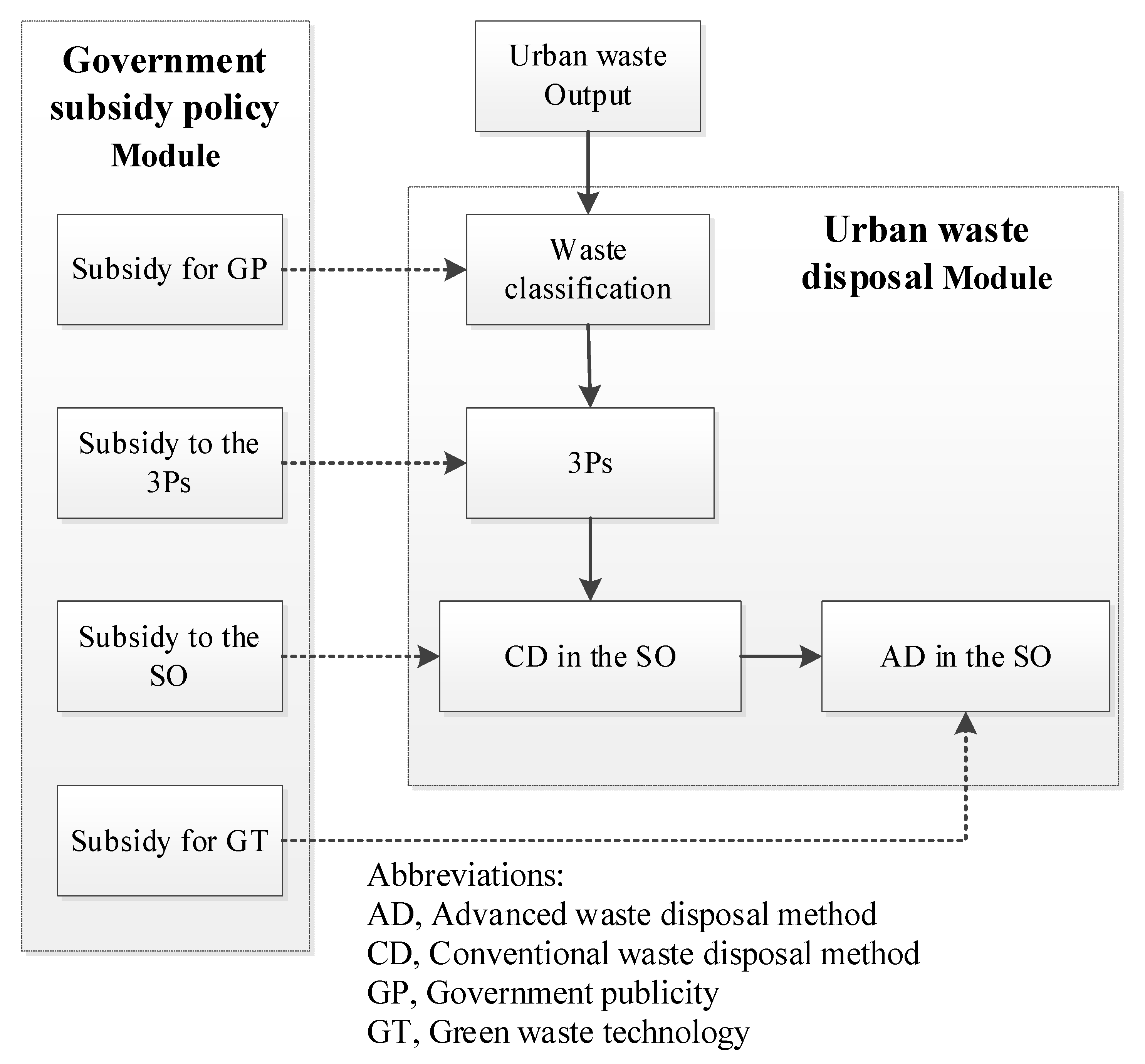

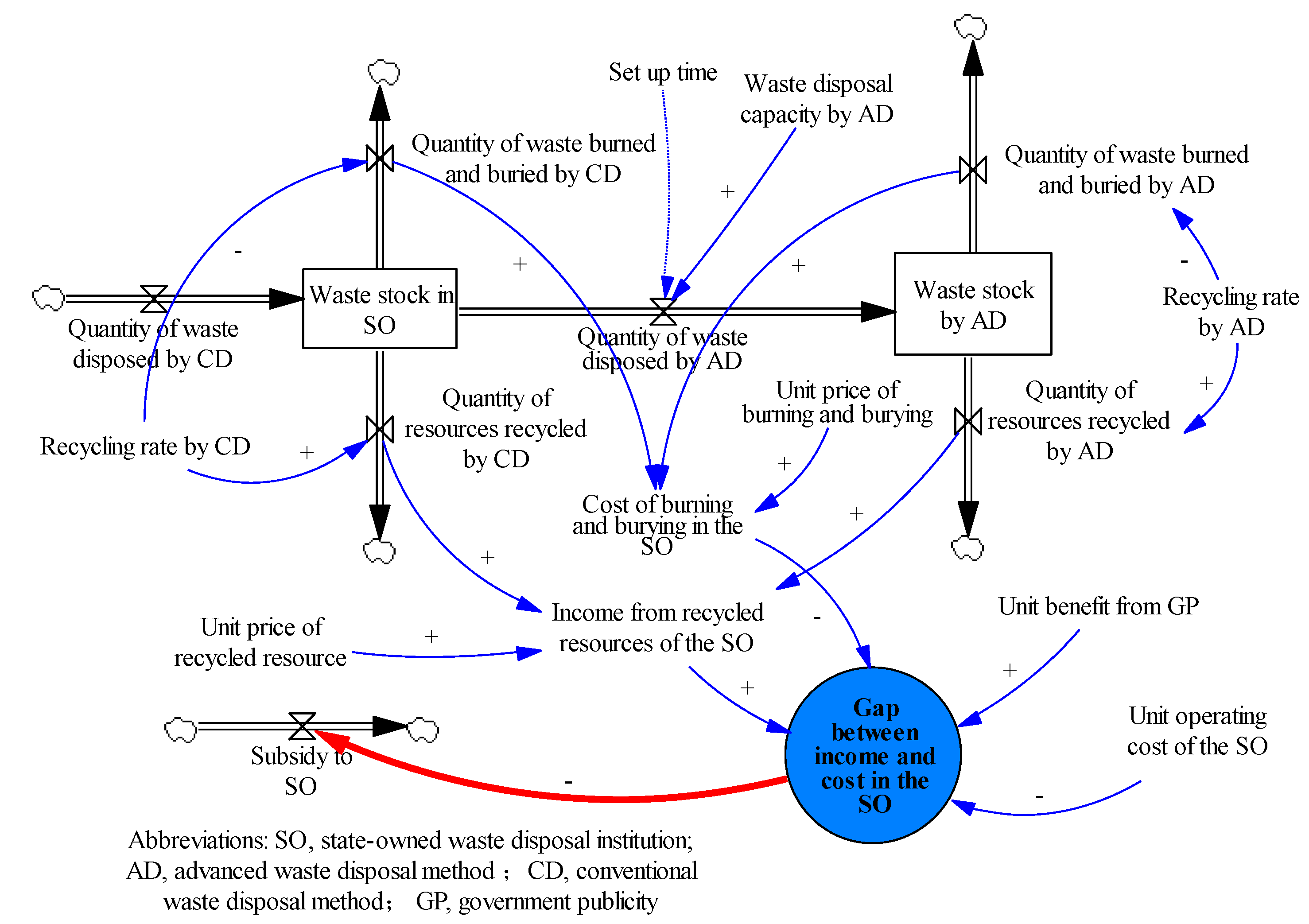
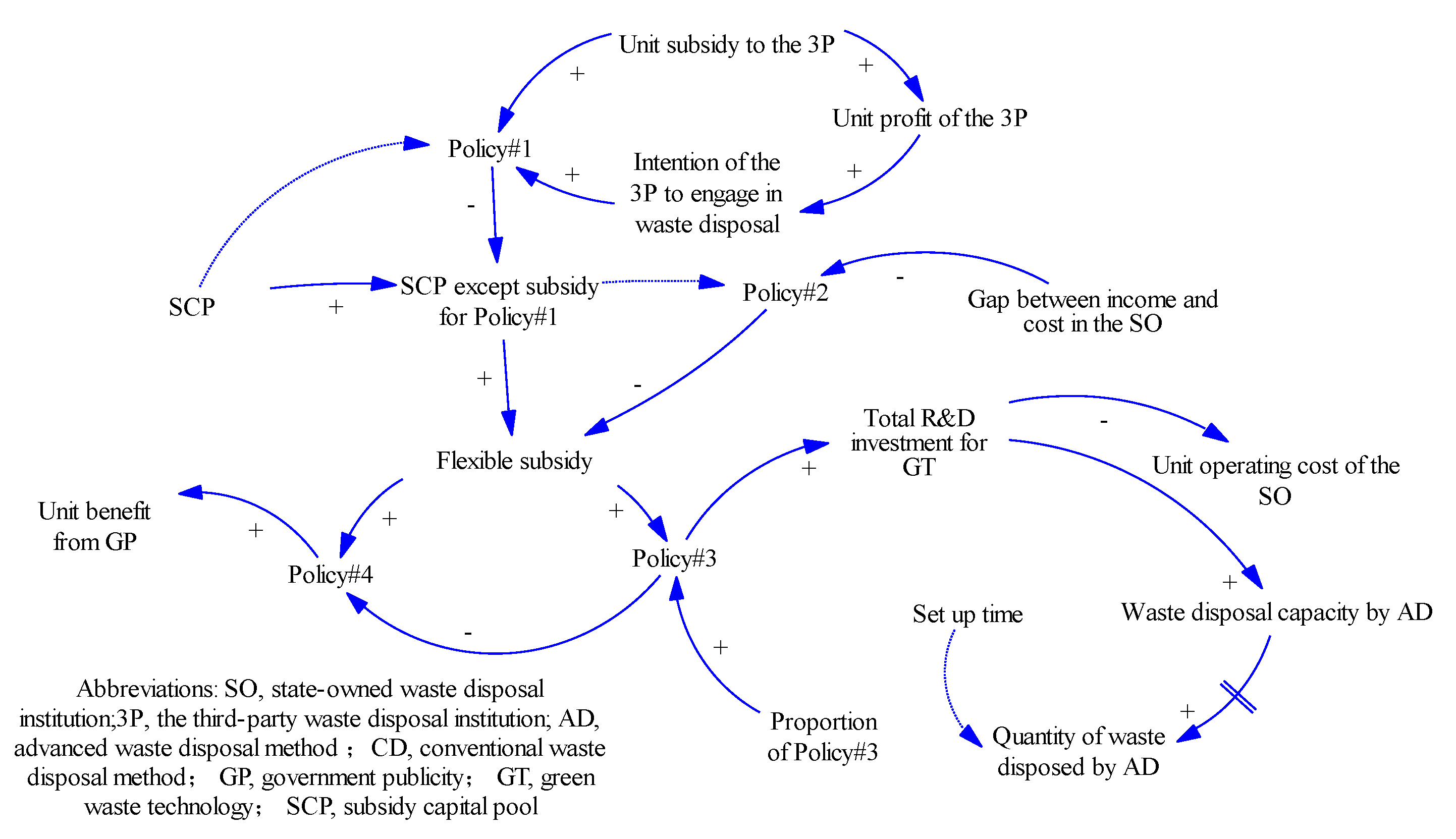

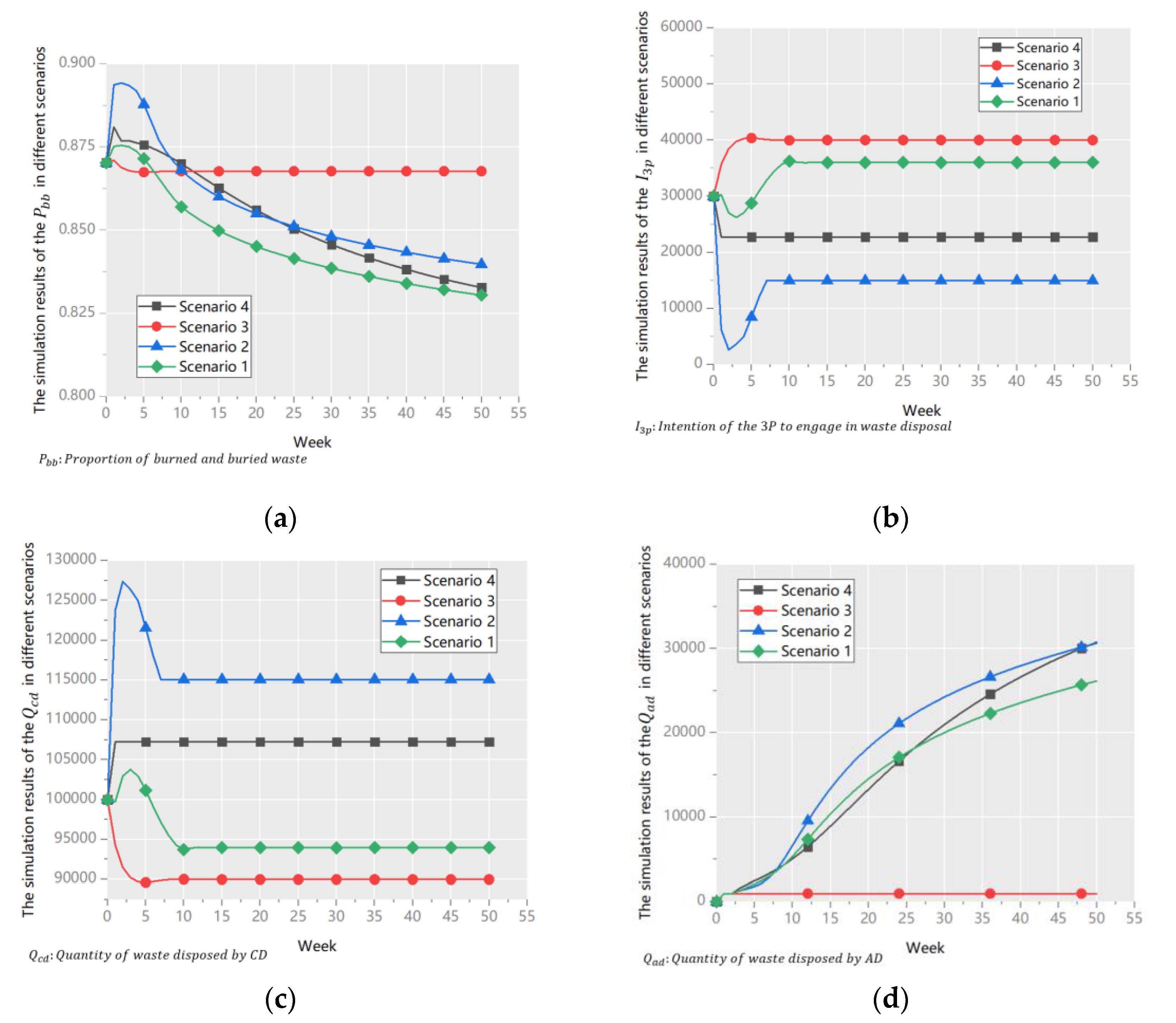
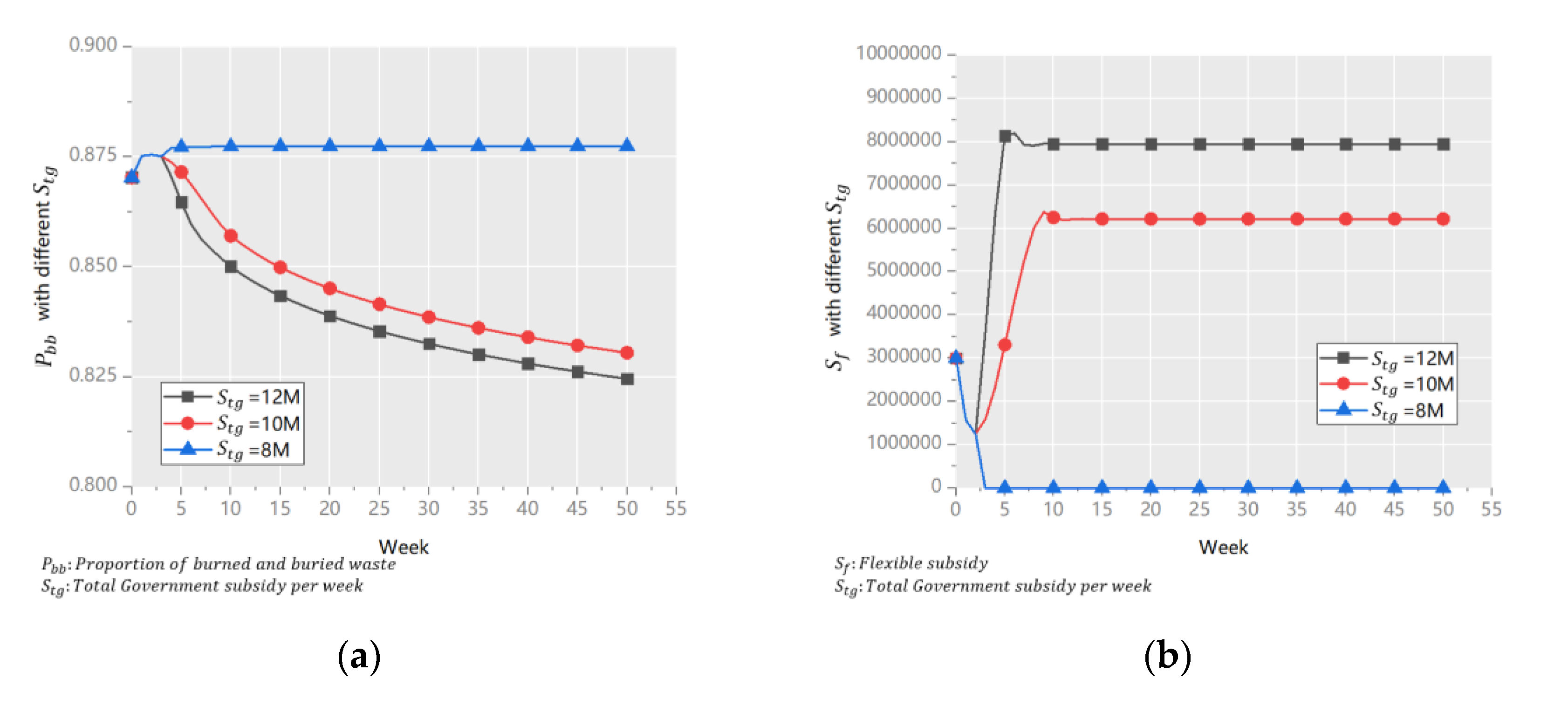
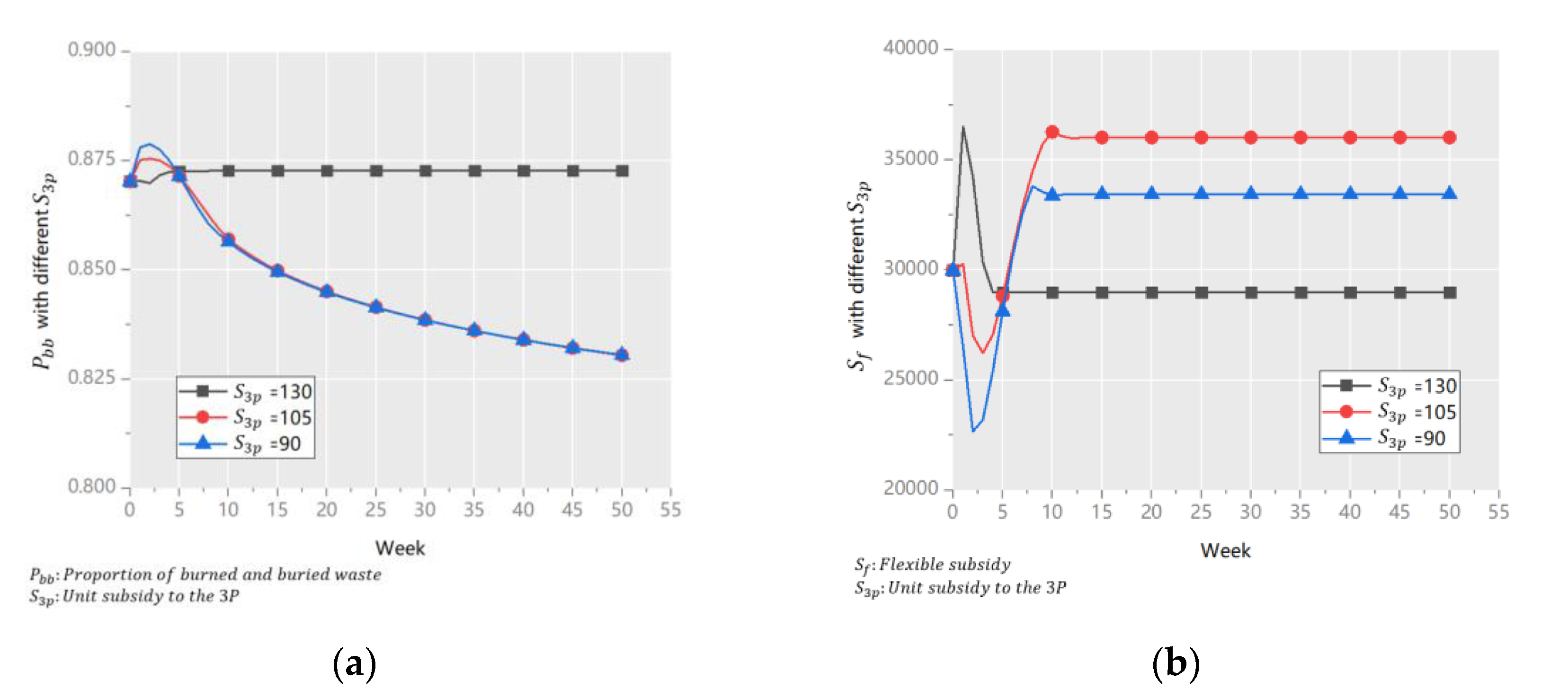
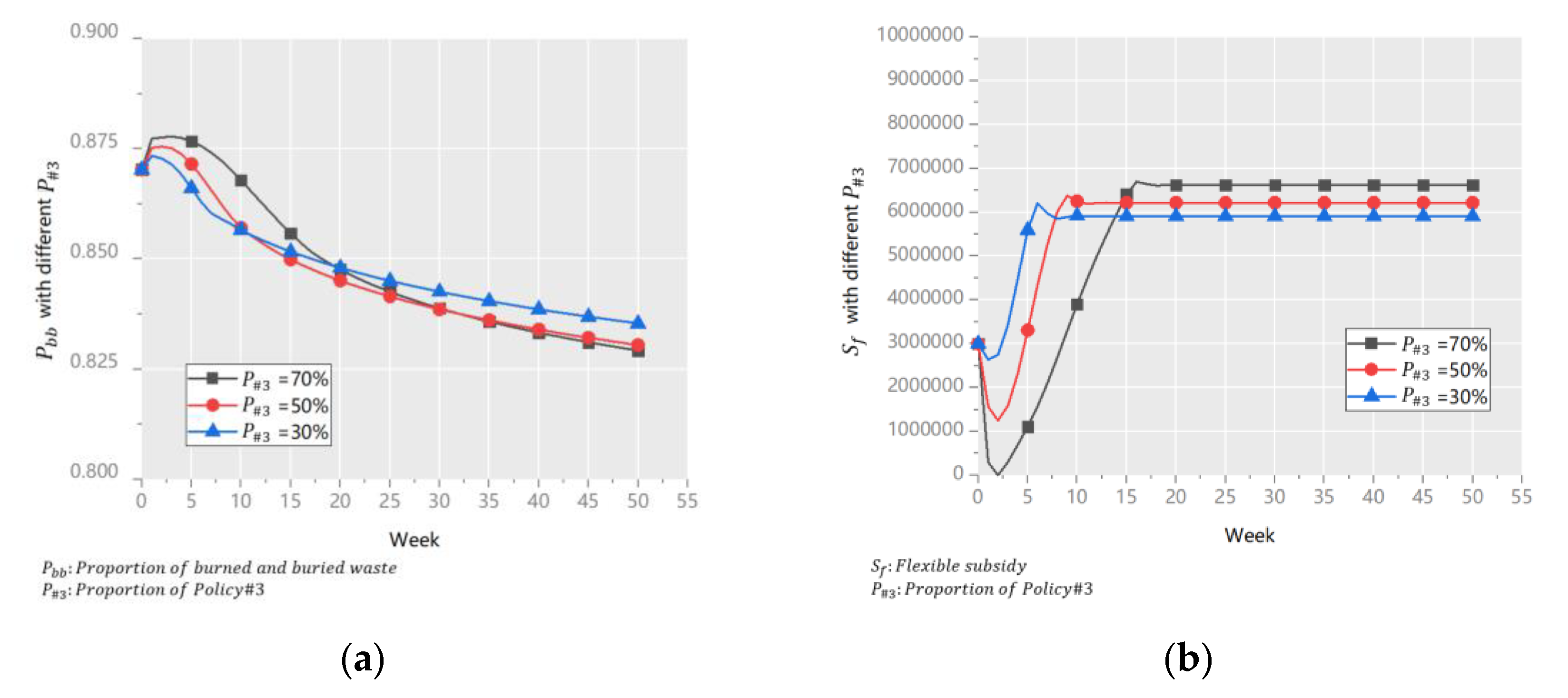
| Country | Incentive Subject | Incentive Mechanism | Description/Result | Reference |
|---|---|---|---|---|
| Incentive Mechanism for Recycling Recyclable Waste | ||||
| U.K | Recycling Companies | Recycling Subsidy | It used a two-level programming model to analyze the government’s optimal strategy for subsidizing recycling. | [38] |
| China | Recycling Companies | Profit Compensation Mechanism | In order to achieve a balance between corporate profits and social responsibilities, the government coordinates the reverse supply chain through a profit compensation mechanism. | [39] |
| Europe | Manufacturing Companies | Reward & Punishment | The government’s reward and punishment can guide producers to give full play to their extended responsibility. Inspired by the subsidy, producers will vigorously carry out the construction of reverse logistics supply chains, innovate technology for green product designs, and improve their resource reuse efficiency. | [40] |
| China | Manufacturing Companies | Subsidies | It analyzed the impact of four kinds of subsides on circular development: initial subsidy, recycling subsidy, R&D subsidy, production subsidy. | [41] |
| Bangladesh | Customers &Recycling Agencies | Tax Credits | Tax credits subsidy is given to agencies who are assigned to collect e-waste and consumers to encourage them in order to bring their e-waste for recycling. However, it imposes an additional burden on both from the financial and administrative side of the Government | [42] |
| Iran | Manufacturers & Retailers | Tax exemption and subsidy | It compared the government’s role in providing different incentive strategies (tax exemption and subsidy) for closed-loop supply chain members | [43] |
| USA | Customers, Manufacturers & E-NGOs | Tax | It compared the government mechanisms of imposing taxes on manufacturers and setting recovery rates as penalty targets. The results showed that the choice of mechanism varies according to the perspective of the stakeholder. | [44] |
| Incentive Mechanism for Recycling LVRW | ||||
| China | Resident | Reward | Appropriate subsidies can guide residents to recycle LVRW, which can alleviate the problem of low rate of LVRW. | [45] |
| Czech Republic | Resident | Reward | It explored that implementing a reward subsidy program can double the existing paper and plastics separation rates. | [24] |
| India | Resident | Mixed policies | It simulated four major policy interventions and explored that while composite combinations of policies offer more effective policy mix than individual policy interventions, a suitable choice of policy mix along with its timing and extent is crucial. | [25] |
| Canada | Manufacturing Companies | Pricing Schemes | In order to reduce single-use plastic (SUP) waste, the EPR system is implemented and pricing subsidies are adopted to increase the waste recovery rate. | [26] |
| China | Recycling Companies | Special Subsidy | It explored the special subsidy which can be carried out directly (assistance payment) or indirectly (subsidize R&D projects, etc.). | [11] |
| China | 3Ps | Processing Subsidies | According to the amount of LVRW recycled and reused, 3Ps obtain processing subsidy by the government, which effectively promoting the recycling and classification of LVRW by 3Ps. | [46] |
| China | Recycling all Participants | Mixed Subsides | Aiming at the best recovery efficiency, this paper discusses a mixed subsidy policy model on the basis of considering the government fixed subsidy capital pool. | Current study |
| No. Unit Profit | 1 | 2 | 3 | 4 | 5 | 6 | 7 | 8 |
|---|---|---|---|---|---|---|---|---|
| 100 | 0.2 | 0 | 0.05 | 0 | 0.05 | 0 | 0.1 | 0.05 |
| 200 | 0.3 | 0.2 | 0.1 | 0.3 | 0.1 | 0.2 | 0.2 | 0.2 |
| 300 | 0.4 | 0.3 | 0.2 | 0.5 | 0.3 | 0.35 | 0.4 | 0.4 |
| 400 | 0.55 | 0.5 | 0.4 | 0.75 | 0.4 | 0.55 | 0.55 | 0.7 |
| 500 | 0.75 | 0.7 | 0.65 | 1 | 0.6 | 0.7 | 0.75 | 1 |
| 600 | 1 | 1 | 1 | 1 | 1 | 1 | 1 | 1 |
| Max capacity | 30 | 10 | 60 | 15 | 20 | 25 | 20 | 20 |
| Unit profit of 3P (Chinese Yuan, CNY) | 0 | 100 | 200 | 300 | 400 | 500 | 600 |
| Intention of the 3P to engage in waste disposal (thousand tons/week) | 0 | 13 | 36.5 | 65.25 | 103.5 | 148 | 200 |
| Variable | Equation Description |
|---|---|
| Unit profit of the 3P | Unit subsidy for the 3P + Unit income from recycled resource in the 3P + Unit benefit from GP − Unit operating cost of 3P − Unit cost of burning and burying in the 3P |
| Unit income from recycled resource in the 3P | Unit price of recycled resource × Recycling rate of 3P |
| Unit cost of burning and burying in the 3P | Unit price of burning and burying × (1 − Recycling rate of 3P) |
| Unit benefit from GP | Refer to the government subsidy policy module |
| Waste stock in the 3P | ∫ (Intention of the 3P to engage in waste disposal—Quantity of waste burned and buried in the 3P -Quantity of recycled resource in the 3P) |
| Quantity of recycled resources in the 3P | Waste stock in the 3P × Recycling rate of the 3P |
| Quantity of burned and buried waste in the 3P | Waste stock in the 3P − Quantity of recycled resources in the 3P |
| Policy#4 (CNY) | 0 | 1M | 2M | 3M | 4M | 5M | 7M | 10M |
| Unit benefit from GP (CNY) | 0 | 20 | 37 | 52 | 64 | 74 | 94 | 109 |
| Coefficient | Results | Std. Error | t-Statistic | Prob. |
|---|---|---|---|---|
| 78.25234 | 6.006924 | 13.02702 | 0.0000 | |
| 3185,291 | 395,232.7 | 8.059280 | 0.0005 | |
| Main fitting test parameters | Results | |||
| R-squared | 0.997052 | |||
| Adjusted R-squared | 0.996462 | |||
| S.E. of regression | 1.854672 | |||
| Mean dependent var | 64.28571 | |||
| Durbin-Watson stat | 2.153398 | |||
| Variable | Values | Unit | Data Sources |
|---|---|---|---|
| (1) Urban waste output rate | 0.13 million | Ton/week | Mean value of weekly waste output data in Guangzhou from 2019 to 2020. |
| (2) Unit price of burning and burying | 56 | CNY/ton | According to the urban waste disposal report of Guangzhou in 2020, the costs of burning and burying are 145 CNY/ton and 21 CNY/ton respectively, with a proportion of 2:5. The value in this paper is the weighted average value. |
| (3) Unit operating cost of the SO | 80 | CNY/ton | Guangzhou statistical yearbook |
| (4) Unit operating cost of the 3P | 60 | CNY/ton | Average value of 8 3Ps |
| (5) Unit price of recycled resource | 600 | CNY/ton | The main components of LVRW are wood chips, cartons and other recycled resources, and the weighted average value is taken according to the proportion and the price of different recycled resource. |
| (6) Set up time | 4 | week | Practical experience |
| (7) Unit subsidy for the 3P | 105 | CNY/ton | Guangzhou statistical yearbook |
| (8) Government total subsidy per week | 10 million | CNY | Guangzhou statistical yearbook |
| (9) Recycling rate by CD | 10% | Dmnl | Guangzhou statistical yearbook |
| (10) Recycling rate of the 3P | 20% | Dmnl | Average value of 8 3Ps |
| (11) Recycling rate by AD | 30% | Dmnl | According to the data of Guangzhou statistical yearbook in 2020, 14% of the total waste in Guangzhou is directly recyclable, and 38% is the LVRW [8]. According to international advanced standards, the highest recovery rate of direct recyclable part of waste is 80%, and the highest recovery rate of LVRW is 50%. It can be calculated that Recycling rate by AD = Direct recyclable × its highest recovery rate + LVRW × its highest recovery rate = 14% × 80% + 38% × 50%≈30% |
| (12) Proportion of Policy#3 | 50% | Dmnl | Initial value |
| Code | Variable |
|---|---|
| I3p | Intention of the 3P to engage in waste disposal |
| P#3 | Proportion of Policy#3 |
| Pbb | Proportion of burned and buried waste |
| Qcd | Quantity of waste disposed by CD |
| Qad | Quantity of waste disposed by AD |
| Stg | Total Government subsidy per week |
| Sf | Flexible subsidy |
| S3p | Unit subsidy to the 3P |
Publisher’s Note: MDPI stays neutral with regard to jurisdictional claims in published maps and institutional affiliations. |
© 2021 by the authors. Licensee MDPI, Basel, Switzerland. This article is an open access article distributed under the terms and conditions of the Creative Commons Attribution (CC BY) license (https://creativecommons.org/licenses/by/4.0/).
Share and Cite
Sun, D.; Xie, D.; Jiang, P.; Xie, J.; Xu, Y.; Ren, Y. Simulating the Effect of Mixed Subsidy Policies on Urban Low-Value Recyclable Waste in China: A System Dynamics Approach. Int. J. Environ. Res. Public Health 2021, 18, 10636. https://doi.org/10.3390/ijerph182010636
Sun D, Xie D, Jiang P, Xie J, Xu Y, Ren Y. Simulating the Effect of Mixed Subsidy Policies on Urban Low-Value Recyclable Waste in China: A System Dynamics Approach. International Journal of Environmental Research and Public Health. 2021; 18(20):10636. https://doi.org/10.3390/ijerph182010636
Chicago/Turabian StyleSun, Dongshi, Danlan Xie, Peng Jiang, Jingci Xie, Yang Xu, and Yining Ren. 2021. "Simulating the Effect of Mixed Subsidy Policies on Urban Low-Value Recyclable Waste in China: A System Dynamics Approach" International Journal of Environmental Research and Public Health 18, no. 20: 10636. https://doi.org/10.3390/ijerph182010636
APA StyleSun, D., Xie, D., Jiang, P., Xie, J., Xu, Y., & Ren, Y. (2021). Simulating the Effect of Mixed Subsidy Policies on Urban Low-Value Recyclable Waste in China: A System Dynamics Approach. International Journal of Environmental Research and Public Health, 18(20), 10636. https://doi.org/10.3390/ijerph182010636







